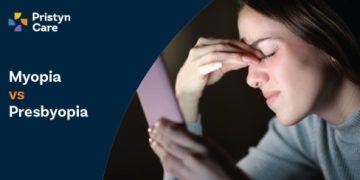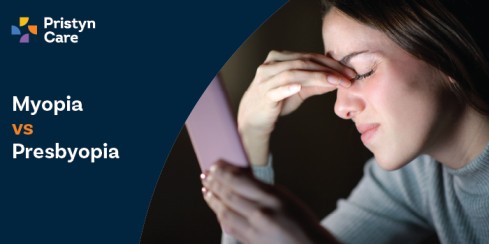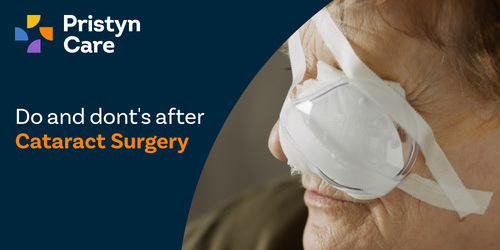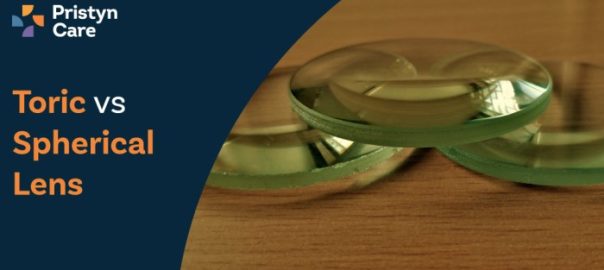![]() Views: 32
Views: 32
Myopia Vs Presbyopia
Do you struggle to see distant objects clearly or find it hard to read fine print? You might be dealing with myopia or presbyopia. Myopia, also known as nearsightedness, makes distant objects appear blurry, while presbyopia impairs your ability to see close objects as you get older.
Dedicated Support at Every Step!
Our Doctors are available 24 hours a day, 7 days a week to help you!
This blog talks about the causes, symptoms, and treatment options for both conditions. We will equip you with clear, professional advice that helps you understand and manage these common vision problems. Whether you are personally affected or assisting someone else, learning about myopia and presbyopia is a vital step towards improved eye health.
Table of Contents
What is Myopia?
Myopia, commonly known as nearsightedness, is a vision condition where objects close to you appear clear, but those far away blur. This condition occurs when the eyeball is too long relative to the focusing power of the cornea and lens. As a result, the light that enters the eye doesn't focus directly on the retina but in front of it.
Causes of Myopia
Understanding why myopia develops is crucial for both prevention and treatment. Here are the main factors:
- Genetics: If your parents are nearsighted, you are more likely to develop myopia.
- Environmental influences: Spending excessive time on near tasks, like reading or using electronic devices, can contribute to the development of myopia.
- Lack of outdoor activity: Research suggests that natural light exposure might play a role in reducing myopia risk.
These factors highlight the complex interplay of genetic predisposition and lifestyle habits in the development of myopia.
Symptoms and Diagnosis
Identifying myopia early can help manage its progression. Here’s what to watch for and how it is diagnosed:
- Blurred vision: Difficulty seeing distant objects clearly is a primary symptom.
- Squinting: You might find yourself squinting to see better.
- Eye strain: Frequent headaches or eye strain can occur when you overexert your vision.
- Needing to sit closer: You might need to sit nearer to the television or at the front of the classroom to see clearly.
No Cost EMI, Hassle-free Insurance Approval
What is Presbyopia?
Presbyopia is a common age-related vision condition where the ability to focus on close objects gradually diminishes. It typically begins in the early to mid-40s and is a natural part of the ageing process.
Unlike myopia or hyperopia, which are related to the shape of the eyeball, presbyopia stems from the hardening of the lens inside the eye. This hardening prevents the lens from changing shape to focus on nearby objects, making tasks like reading or threading a needle challenging.
Causes of Presbyopia
The development of presbyopia is inevitable for most people and is primarily caused by age-related changes within the eye. Key factors include:
- Loss of elasticity: Over time, the lens of the eye thickens and loses its elasticity, reducing its ability to change shape.
- Age: Presbyopia generally starts to affect people from the age of 40 onwards.
- Decreased flexibility: The muscles surrounding the lens can weaken as you age, further hindering the lens's ability to focus.
These changes result from natural physiological ageing processes that affect the eye's internal structures.
Symptoms and Diagnosis
Recognising the symptoms of presbyopia early can help you seek corrective measures sooner. Common signs include:
- Difficulty reading small print: You might find yourself holding books or menus farther away to read clearly.
- Eye strain: Experiencing headaches or visual fatigue after doing close work could be a symptom.
- Needing brighter lighting: You may notice a need for more light when reading or doing close tasks.
Comparing Myopia and Presbyopia
Myopia and presbyopia are common vision conditions that affect millions of people worldwide. While they may seem similar because they both influence vision, their causes, symptoms, and impacts on vision over time differ significantly.
Differences in Causes
The causes of myopia and presbyopia stem from different anatomical changes in the eye, which lead to distinct vision issues:
- Myopia:
- Eye Shape: Myopia occurs when the eyeball is too long relative to the focusing power of the cornea and lens, causing light rays to focus in front of the retina.
- Genetics: It often runs in families, suggesting a strong genetic link.
- Lifestyle Factors: High levels of close work, like reading or screen use, can increase the risk of developing myopia.
- Presbyopia:
- Ageing Lens: Presbyopia is primarily caused by the natural ageing process. As you age, the lens of your eye becomes less flexible, making it harder to focus on close objects.
- Loss of Muscle Flexibility: The muscles around the lens also lose their elasticity, further reducing the eye’s ability to focus on near tasks.
- Universal Development: Unlike myopia, which can develop at various ages, presbyopia generally affects individuals over the age of 40.
Differences in Symptoms
The symptoms of myopia and presbyopia are quite distinct, primarily affecting how individuals perceive objects at different distances:
- Myopia:
- Distant Blur: People with myopia typically have clear vision for close objects but blurry vision for objects that are far away.
- Squinting: Squinting to see distant objects more clearly is a common symptom.
- Eye Strain: Myopic individuals often experience eye strain and headaches from attempting to focus on distant objects.
- Presbyopia:
- Near Blur: Individuals with presbyopia find it difficult to read small print or see close objects clearly without corrective lenses.
- Holding Objects Farther Away: There is a tendency to hold reading material further away to see the words more clearly.
- Need for More Light: People with presbyopia often need brighter lighting when doing close work.
Impact on Vision Over Time
The progression and impact of myopia and presbyopia on vision over time also differ:
- Myopia:
- Progression: Myopia can develop rapidly, especially during childhood and adolescence. Its progression can sometimes stabilise in early adulthood but can also continue to worsen with age.
- Complications: Severe myopia increases the risk of other eye conditions, such as retinal detachment, glaucoma, and cataracts.
- Presbyopia:
- Inevitability: Presbyopia continues to progress as part of the ageing process. Nearly everyone experiences some degree of presbyopia after the age of 40.
- Adjustments in Vision Correction: The degree of presbyopia deepens over time, often requiring changes in the prescription of reading glasses or contact lenses.
MS, DNB, FICO, MRCS, Fellow Paediatric Opth and StrabismusMobile
FREEConsultation Fee
Treatment Options
When dealing with vision impairments like myopia and presbyopia, understanding the various treatment options available is crucial for effective management. These treatments not only improve vision but also enhance the quality of life for those affected.
Treatment Options for Myopia
Several effective treatments are available to manage myopia and help individuals see distant objects more clearly:
- Glasses and Contact Lenses: The most common and simplest form of treatment involves corrective lenses. Glasses or contact lenses correct the focus, allowing for clearer vision at distances.
- Orthokeratology: This involves wearing specially designed rigid contact lenses that temporarily reshape the cornea. You wear these lenses overnight and remove them during the day, which can provide clearer vision without the need for glasses or contacts during waking hours.
- Atropine Eye Drops: Low-dose atropine eye drops have been used to slow the progression of myopia in children. This treatment helps to reduce the elongation of the eyeball over time.
- Refractive Surgery: Procedures such as LASIK or PRK reshape the cornea permanently using a laser, correcting the refractive error that causes myopia. These surgeries are usually recommended for adults whose eye measurements have stabilised.
Treatment Options for Presbyopia
As presbyopia is linked to the natural ageing process, treatments focus on improving near vision:
- Reading Glasses: Simple over-the-counter reading glasses can be used to correct presbyopia effectively. These glasses help focus near objects, making reading and other close work easier.
- Bifocals and Progressive Lenses: These corrective lenses offer multiple focal points, eliminating the need to switch between different pairs of glasses for near and distant vision.
- Contact Lenses: Multifocal contact lenses offer a convenient alternative to glasses, providing clear vision at all distances.
- Surgical Options: Surgical treatments like monovision LASIK, where one eye is corrected for near vision and the other for distance, can be an option. There’s also presby-LASIK, an emerging technique that creates different zones on the cornea for different ranges of vision.
Advances in Medical Technology for Both Conditions
Recent technological advancements have significantly improved treatment options for both myopia and presbyopia, enhancing effectiveness and comfort:
- Custom Wavefront Technology: This advanced technology for LASIK surgery uses detailed mapping of the eye to achieve precise corrections, tailored to individual optical requirements. It reduces risks and improves the accuracy of refractive surgeries.
- Phakic Intraocular Lenses (IOLs): These lenses are implanted inside the eye without removing the natural lens. They are particularly useful for those with severe myopia.
- Extended Depth of Focus IOLs: These are designed for treating presbyopia. The lenses extend the range of clear vision with a single optical element, reducing dependency on glasses.
- Corneal Inlays: A small device is implanted in the cornea of one eye to improve near vision. It’s a less invasive option that can be particularly beneficial for those with presbyopia.
Preventive Measures and Eye Health
Taking proactive steps to maintain eye health can prevent or delay the onset of common vision problems such as myopia and presbyopia. Here, we see practical approaches to eye care that can help preserve vision over time.
Preventive Care for Maintaining Eye Health
Preventive care is key to keeping your eyes healthy throughout your life. Here are several effective strategies:
- Screen Time Management: Limit the amount of time spent on screens. Take regular breaks using the 20-20-20 rule: every 20 minutes, look at something 20 feet away for at least 20 seconds.
- Proper Lighting: Ensure adequate lighting when reading or doing tasks that require visual precision to avoid eye strain.
- Eye Protection: Wear protective eyewear when engaging in activities that could lead to eye injuries, including sports or DIY projects at home.
- UV Protection: Always wear sunglasses with complete UV protection to shield your eyes from harmful sun rays, which can accelerate conditions like cataracts and macular degeneration.
- Quit Smoking: Smoking can increase the risk of developing age-related macular degeneration, cataracts, and optic nerve damage.
Importance of Regular Eye Exams
Regular eye exams are crucial for detecting eye conditions early and managing them effectively:
- Early Detection: Many eye diseases, such as glaucoma, have no symptoms in the early stages. An eye exam can detect these conditions before they lead to significant vision loss.
- Update Prescriptions: Regular check-ups ensure that any changes in vision can be corrected promptly with updated prescriptions for glasses or contact lenses.
- Overall Health Checks: Eye exams can reveal symptoms of other health issues, such as diabetes and high blood pressure, reflected in the eye’s blood vessels.
Role of Diet and Lifestyle in Eye Health
A healthy lifestyle and a balanced diet play significant roles in maintaining good eye health:
- Nutrient-Rich Diet: Eating foods high in omega-3 fatty acids, lutein, zinc, and vitamins C and E can help ward off age-related vision problems like macular degeneration and cataracts. Green leafy vegetables, oily fish, eggs, nuts, and oranges are great choices.
- Hydration: Keeping well-hydrated is important for maintaining moisture in the eyes, helping to prevent dry eyes and irritation.
- Physical Exercise: Regular physical activity can help improve blood circulation, which is important for maintaining healthy eye function and can reduce the risk of age-related vision problems.
- Weight Management: Maintaining a healthy weight can reduce the risk of diabetes, which can lead to diabetic retinopathy or vision loss.
Key Takeaways on Vision Differences
To effectively manage and understand eye health, you must recognise the distinctions between myopia and presbyopia. Myopia typically develops early in life, affecting distance vision, while presbyopia emerges as a part of the ageing process, impairing near vision. Millions around the world experience these conditions, influencing daily tasks and overall quality of life.
Scheduling regular eye examinations is vital for timely identification and treatment. Moreover, adopting healthier lifestyle choices may support eye health and potentially mitigate the progression of these visual impairments.
For anyone experiencing these vision changes or aiming to prevent them, consulting with an eye care specialist is crucial to determine the most suitable management strategies.










